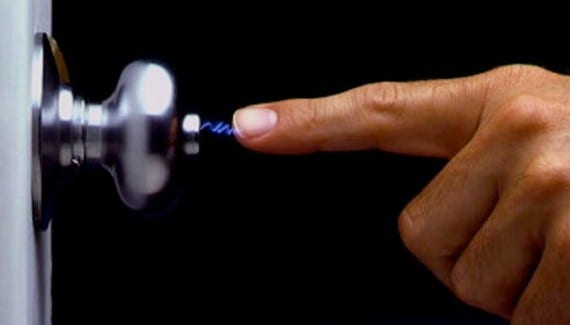
Many owners of Apple’s new 27-inch iMacs are thrilled with the low cost of OWC memory upgrades compared to what Apple charges to have the memory factory-installed. While these upgrades are fast and easy to install, you’ll want to take some precautions for keeping your new 2019 iMac and the memory upgrades safe from static electricity discharges.
What is Static Electricity and Why Is It Dangerous to Electronics?
Static electricity is an imbalance of electric charges within or on the surface of a material. That charge remains “static” in the material until it is able to move away through either an electric current or an electrical discharge. Just about every human has experienced a static shock — an electric discharge that occurs when the excess charge that your body and clothing has accumulated is neutralized by touching an electrical conductor. These shocks can be seen, heard and definitely felt. That feeling is the stimulation of nerves in your finger as the current flows through your body to the grounding surface (another person or object, a door knob, and so on).
Think of static electricity as a lightning storm on a much smaller scale and you have the right idea. Researchers who are modeling the effects of static electricity often think of the human body as a capacitor (an electrical component) with a capacity of 100 picofarads and charged to a voltage of between 4,000 and 35,000 volts. Touching an object releases that energy in less than a microsecond — one millionth of a second.
While static shocks are an unwelcome and annoying surprise in everyday life, they can be damaging to electronic devices that are usually powered by 5 to 10 volts (see image below). That’s why it is important to know what can cause a static buildup and how to discharge it before you open a device and handle electronic components.

What Causes Static Electricity to Build Up?
Usually it’s due to something called the triboelectric effect, which causes some materials to lose electrons and others to gain them. You might remember experiments in school where you rubbed different materials against each other to build up a static charge, like fur on an acrylic rod or a balloon against your hair. That effect can cause static buildup from just walking across carpeting, or moving something against a plastic surface.
Even certain types of clothing can build up static charges, which is why both antistatic fabric softeners and dryer sheets are so popular when doing laundry.
Some Practices To Follow Before Starting An Upgrade
Before you begin any upgrade, you should turn your computer fully off. Next, keep any of the electronic components you’ll be installing inside their antistatic bags until you’re ready to install them. Those bags are designed to protect memory and drives from accumulating static charges, so keep the components inside until you need them.
Upgrades come with connectors to attach them to the computer for data and power transmission. Always handle drives and memory modules by the edges away from those connectors so you don’t accidentally “zap” the sensitive electronics. One final note: if you’ve just received an upgrade in the mail on a cold, dry day, let the components reach room temperature before you install them. A temperature differential can cause static electricity to build up even faster.
Next, discharge any static electricity from your body before starting. You might remember as a child annoying your siblings and friends by dragging your stockinged feet across the carpet to build up a big static charge, then zapping them with the shock. You may not feel that spark that you did when you were a kid, but touching a grounded object before you begin your upgrade will help.
What’s a good grounded object? Usually, if your computer is turned off, has a metal chassis or body, and is plugged into a grounded outlet, just touching the computer body discharges any static buildup you may be carrying.
If you plan on doing a lot of upgrades, consider buying an iFixit Portable Antistatic Mat ($29.99). This mat is made of an antistatic material and includes a grounding wrist strap and cord. These mats come with complete instructions for use, and be sure to read those instructions before you begin.
Have A “Static-Free Zone” For Performing Upgrades
Once you’re ready to go with your upgrade, there are some guidelines you should follow to prevent static discharges. Make sure that you have a clean, dry and static free surface. Many people use kitchen tables for these purposes, but it’s important to have something soft on that surface to protect the computer (especially important if you’re opening a 27-inch iMac, face down). A common cotton towel that has been cleaned and then run through a dryer with an anti-static dryer sheet is perfect.
Here are some other guidelines:
- Keep pets out of the area that you’ll be working in. Cats (see image below) are famous for being static electricity generators and they’re naturally inquisitive, so their “help” can inadvertently zap your upgrades or your computer. Make sure they’re out of the room.

- Keep the humidity in the work area between 35 and 50 percent. Cold winter days with a furnace running and warm summer days with air conditioning blasting can dry out the air, making it easier for surfaces to pick up electrical charges.
- Make sure the workspace is cleared off prior to beginning work. Cellophane or other plastic wraps, paper, and other items being moved on the work surface can generate static. Even bumping against a plastic garbage can can cause static to be transferred to you…and then to the electronics.
- Are you standing on carpet or a rug? Many stores carry anti-static sprays that you can apply to the surface you’ll be standing on.
Just spending a few minutes creating a static-free zone for installing your upgrades can ensure a successful upgrade and years of productivity and fun with your new computer.








Thanks for the reminder. I purchased your RAM upgrade for my Mac Pro and it still sits in its original packaging because it’s been a very long winter and I’m leery of static discharges. It’s warmer now, so I’ll install it next week before the A.C. gets turned on. Of course, that eliminated the old RAM return policy for me, but it’s worth not zapping my new RAM.
Awesome article. Many thanks!